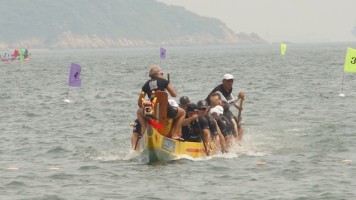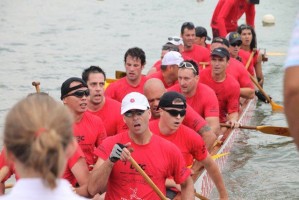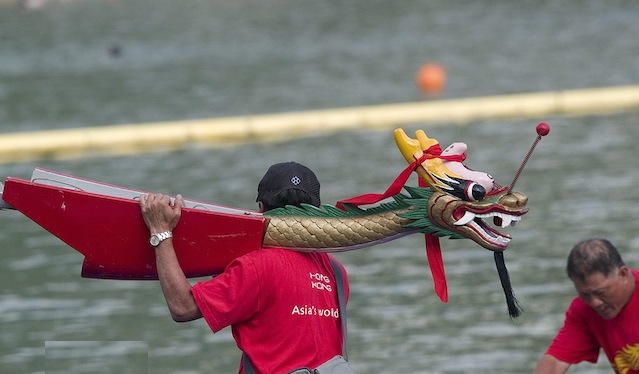By Tammy Allman
Translations by Jessica Wong
It’s pitch black. The dense silence is interrupted occasionally by the bark of a dog in the distance and is punctuated at regular intervals by the soft swish of twenty paddles spearing the water in perfect unison.
“Let it run!” booms a loud voice out of the darkness, and the swish of the paddles ceases, to be replaced by the sound of heavy and rapid breathing as the paddlers take a well-earned break and the boat is allowed to run to a stop in the water.
This is evening training with the Stormy Dragons, one of 98 dragon boat clubs currently registered with the Hong Kong Dragon Boat Association.
Dragon boating is a physically intense and demanding sport and has a long and rich cultural heritage in Hong Kong, Taiwan and Mainland China. In Hong Kong, dragon boating was a traditional pastime of fishermen, and today it is only they who observe the rituals associated with dragon boating in a spiritual context. But as the fishing communities dwindle and paddling, as it is now commonly known, becomes increasingly more popular with westerners – both within the expat community in Hong Kong and globally – many of the old traditions are in danger of being watered down, if not lost completely.
Jessica Wong, 28, who paddles for Stormy’s, has experienced paddling in both the new and old styles. She grew up on Cheung Chau Island, which she explained, “had a large fishing community, so dragon boating has been in my consciousness since I was very young.”
Later, “I had the privilege of paddling with the Tai Tam fishermen team (from Hong Kong Island) and for two seasons I only paddled with them,” she said. She recalled that as a teenager she watched the Aberdeen fishermen’s races and gate-crashed the Stanley after-races party, but she didn’t start paddling herself until she returned to Hong Kong in 2009 after a period of studying and working overseas. “Since I love being on the water and outdoors, and also being from a mixed heritage, dragon boating was an obvious choice,” she said.
Wong explained that Stormy’s trained and housed their boats at Tai Tam Tuk – a small fisherman’s village between Tai Tam and the nearby reservoir – and as one of the few Cantonese speakers on the team, she assumed the role of translator, which fostered a relationship between her and the old fishermen there, such that they invited her to paddle with them.
 Cheryl Fender, founding member of Stormy’s, explained that Stormy’s is one of the few dragon boat teams that train with the fishermen out of a fishing village. “I guess the traditional side is lost on many of the Western teams as they just train out of Stanley,” she said. “They don’t get invited along to traditional events such as the fishermen’s races. Whereas we’ve been very lucky to be invited to a few of them, so we get to see it first-hand.”
Cheryl Fender, founding member of Stormy’s, explained that Stormy’s is one of the few dragon boat teams that train with the fishermen out of a fishing village. “I guess the traditional side is lost on many of the Western teams as they just train out of Stanley,” she said. “They don’t get invited along to traditional events such as the fishermen’s races. Whereas we’ve been very lucky to be invited to a few of them, so we get to see it first-hand.”
The fishermen teams are rich with stories about “back in the day” and how dragon boating in Hong Kong used to be. “Paddling with the fishermen, you always had this festive spirit: the colours, the flags, the food and all that noise; it was like a carnival atmosphere,” said Ah Fat, the main steersman at the Hong Kong Island Paddle Club. But now that he competes as part of IPC, a Western team, “It’s much less of a celebration,” he said.
Ah Fat is from a long-line of Aberdeen fishing families. He says he was born – and lived until he was 20 ““ on a boat. He first became involved with dragon boating as a 10-year-old and is well-versed in the old traditions. He used to follow his father to the different races until one day he was given the opportunity to paddle, and he is still at it. Now in his 50s, he is fit and athletic, his muscular arms toned from decades of paddling and steering.
He reminisces about how dragon boat racing – and the dragon boats and paddling technique – have changed over the years. He said the boats were traditionally wide and heavy and have gradually become more narrow and streamlined. The paddling technique has also changed: “It used to be paddling higher and now its paddling lower (on the body). Partly it’s in response to the boat as the lower stroke is more effective for the newer boats,” he said.
According to Ah Fat, the two main traditions involve how the boat begins and ends the season. The boat blessing, to “awaken” the boat, is performed at the Tuen Ng festival, which marks the beginning of the racing season. This is when the dragon’s head and tail are attached. “You have to go to the temple to pray with the boat and you’d bring down statues of the gods or goddesses onto the boat and parade them around,” he said. “There’d be a lot of offerings going around and particular types of paper being burned. Special ceremonial drumming and dotting the eyes of the boat.”
According to Ah Fat, another tradition no longer practised involved the laying to rest of the boat at the end of the racing season. Traditionally boats were made of teak and would often warp and crack with the changes in temperature and humidity, so ““ once the head and tail were removed and stored back at the temple – it was practice to sink the boats under water by loading them up with stones. The boats sat there until raised and painted with a protective varnish, just before the next Tuen Ng festival.
Dragon boating is thought to have originated in the Pearl River Delta of China more than 2000 years ago. It is reputedly one of the oldest forms of water sports in the world. Chinese folklore suggests that dragon boating and the Tuen Ng festival evolved from the ancient story of a hugely popular politician, the warrior and poet Qu Yuan. Qu Yuan was so distressed at his banishment from his home territory by the Emperor that he drowned himself in protest. He was held in such reverence by the local people that they raced out onto the water in their boats, spearing the water with their paddles, shouting and splashing as noisily as they could to drive away the fish, the evil water spirits and the water dragons away from his body.
Such legends and the way the ceremonies are observed vary in nuance from one fishing community to the next. However, they all reflect a deep reverence for dragon boating.
“The fishermen wouldn’t let women or foreigners paddle,” said Ah Fat. “The dragon was a male god and everything related to the male god, the women weren’t allowed to touch. Even when they put the boat under the water, the women weren’t allowed to touch the boat.” And Westerners? He explained with a chuckle: “The way it used to be said is that “˜gweilo’ (the Cantonese term for foreigners) was “˜white ghost’ or “˜foreign devil’, so why would you get a ghost to paddle a boat? How can that bring good luck?”
But as outside interest in the sport grew, communities realised the need for change. There were benefits to be had from opening up the sport. Women were keen to become involved and as the fishing communities were being dispersed, dragon boating was seen as an important way to keep the community spirit alive. Also, crucially, there was money to be had by opening the sport up to “˜landlubbers’ and foreigners.
Ah Fat explained that the women were initially allowed to compete in the early 1970s, once the boats had been modified: “We took an identical dragon boat,” he said, “and took the dragon head off and changed it to a phoenix, which is considered a female energy in Chinese culture”…So at first the women had the phoenix boats and whenever females paddled, it wouldn’t be called dragon boating, it would be called phoenix boating.” Time progressed, however, and the older generations were no longer involved in the sport and phoenix boating came to an end. Now women compete in dragon boats except, typically, in the 50-man dragon boat, where women are still forbidden due to its spiritual significance.
 According to Stanley Residents Association spokeswoman, Cadence Cheng, “By the early 1970s, the expats were racing against the local Chinese. So to make the [Stanley] races fairer for all – because the Chinese teams dominated the race – around 1975 the organisers allowed expats to compete in a category of their own. This was followed by the introduction of a ladies’ competition towards the end of the 1970s.”
According to Stanley Residents Association spokeswoman, Cadence Cheng, “By the early 1970s, the expats were racing against the local Chinese. So to make the [Stanley] races fairer for all – because the Chinese teams dominated the race – around 1975 the organisers allowed expats to compete in a category of their own. This was followed by the introduction of a ladies’ competition towards the end of the 1970s.”
Today, according to the Stanley Residents Association, the Stanley races are the largest one-day dragon boat event in the world and hold the record for having the highest competitor turnout. Novice corporate teams can purchase a package of 10 training sessions plus the race day admission, including steersman and trainer, for HK$25,150.
“It’s a good thing that there are more people paddling, for sure,” Ah Fat said. “But then you lose the traditional, spiritual side. So if you lose it, what is important is that you remember the history. At the very least you remember, even if it’s no longer practised.”
Lister Woo grew up in Wan Chai and has represented Hong Kong internationally at the world championships and now owns and runs Asia’s main dragon boat equipment manufacturer and supplier. He said, “I started in a way as a corporate crew ““ a bunch of friends started paddling together ““ and from that went to a proper paddling club and got serious.” Woo thinks that including corporate teams in the competitions are a good way of raising the sport’s profile and engendering interest: “I think it’s definitely a good thing. It’s a brewing ground for the more elite athletes. The good guys tend to stick around,” he said.
Ah Fat acknowledged that opening up the sport has brought a more professional dimension. But “without a shadow of a doubt, paddling with the fishermen was always much more fun,” he said, chuckling at the memory. “With the fishermen’s teams anything goes: you want to smoke on board? You want to drink your beer on board? Sure you can, unless it’s during a race. But with IPC it’s no drinking, no smoking on board. “˜It’s not so good for your paddling if you smoke,’ they say. “˜You won’t breathe as well’.”
He says his paddling style now is very much a combination of both traditional and western techniques: “It’s a process of merging from the furious fast arm-stroke that I grew up with, to incorporating the longer stronger stroke of the Westerners that I’ve been shown since.”
Does he think the Western approach to dragon boating is the better way? “It’s just different,” he said laughing. “If it’s a longer race you can guarantee the gweilos will win. But when it’s a short distance: forget it. The Chinese, the fishermen, will always win.”
Read More Stories in CULTURE
 ABOUT THE WRITER
ABOUT THE WRITER
Tammy Allman obtained a degree in English Literature and worked as a high net wealth tax adviser for 14+ years. Following a move to Asia she is now studying for a masters degree in journalism. She has lived in Hong Kong for the past four years with her partner, Jonny, and their little girl, Maggie. Some of her main interests include literature, travel and the study and practice of yoga. She is a supporter and volunteer for the Cambodian Children’s Fund, a Cambodian-based charity. Follow Tammy on Twitter @TammyAllman1




